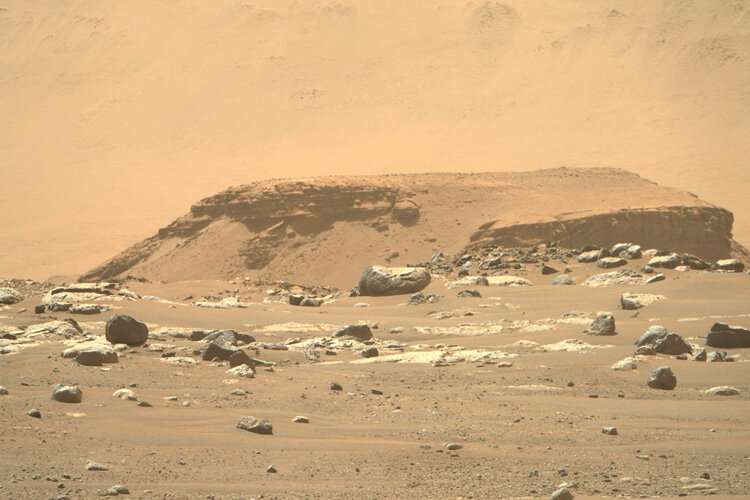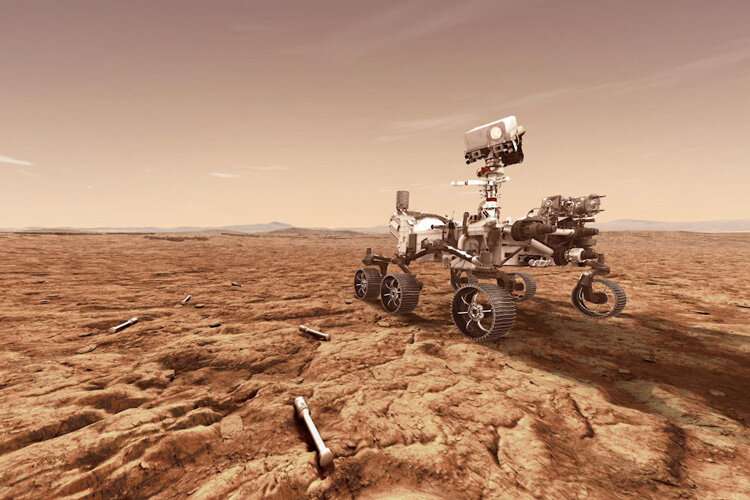18 to start years of exploration. But for him and a subset of the Mars 2020 science team, true gratification will be delayed.
Shuster is one of 15 members of the team focused on sample return, which means that they—or their graduate student successors—won't get their hands on actual Mars rocks for another 10 years, at the earliest. NASA and the European Space Agency will launch two additional missions to collect the rocks that Perseverance sets aside and rocket them back to Earth, ideally by 2031.
Nevertheless, Shuster, a professor of earth and planetary science at the University of California, Berkeley, and a specialist in dating old rocks, isn't bummed. He himself has studied moon rocks brought back by Apollo-era astronauts more than 50 years ago and feels a special affinity with the scientists who protected those precious samples for the benefit of those who came after. He, too, will be helping a new generation of scientists.
"One of the things that motivates me about this mission is the fact that I have benefited from those Apollo samples that were collected before I was born. I know firsthand what it is like to benefit from the really hard work, not just during the actual missions and by the astronauts themselves, but by scientists who curated and documented all of these samples," said Shuster. "I at once appreciate the value of that, but also the importance of doing that carefully for the Mars sample return mission. With all of the science that will be done on these samples, it matters what samples we collect. Not just any old rock works for the things that we do here in the lab."
For him, the key questions are: How old is Jezero Crater, where Perseverance landed, and when did liquid water exist on the surface and deposit the sediments and sculpt the alluvial features clearly visible in the crater? Estimates of the crater's age, which are based on the number of smaller impact craters inside the larger Jezero Crater, range anywhere from 1.7 billion years to more than 3 billion years, he said.
"One of the attractive things about this landing site is that it seems quite clear that at one point in the past—it's unknown as to when—Jezero Crater was a lake, and it was depositing sediment, such as this beautifully preserved fan," he said.
While instruments on board Perseverance can test rocks and sediment for chemical composition and mineralogy, they can't determine age. The radioactive isotope measurements needed to precisely pinpoint age can only be done in labs on Earth.

"Trying to get answers to those questions quantitatively, based on geochemical measurements, is not trivial—this is difficult to do even on Earth," said Shuster, who primarily uses the world-class, state-of-the-art equipment at the independent Berkeley Geochronology Center.
Complicating the analysis, the return samples—a mere 28, if all goes well—will be small, each the size of a stick of blackboard chalk. Scientists plan to analyze them with every chemical and mineralogical technique available, while saving as much of the samples for the future as possible, in hopes of improved analysis techniques. Luckily, though geochronological analysis destroys rock to determine its age, the process requires only tiny pieces.
"The big-picture question is, if we find any evidence for past life on Mars—which is a big motivation behind this mission—the very next question is going to be, 'When was that?'," Shuster said. "We need to know 'when' in an absolute sense, because the next question we are going to ask is, 'What was happening on Earth at that time, and how do these two compare?'"
'A selfless mission'
While Shuster plans to be around to conduct some of that analysis, his graduate student, Andrew "Drew" Gorin, is primed to reap the benefits, too.
"A lot of the people in charge of the mission are going to be retired by the time the samples come back—I feel awed that such a massive team of scientists would embark on such a selfless mission," said Gorin, who came to UC Berkeley last year and hasn't set foot in a campus lab since arriving. "People are dedicating the last 10 years of their career to this and may not get to develop the results themselves. So, it is exciting to be involved in the process as a graduate student."
Shuster, a 1996 UC Berkeley alumnus in geology, has conducted extensive work not only on lunar rocks, but also rocks from Mars: stones that were thrown from the Martian surface by a meteor impact and eventually wended their way through the solar system into Earth's orbit and entered the atmosphere as shooting stars. More than 100 such meteorites from Mars have been identified, but their violent history, combined with likely alterations when leaving Mars and falling to Earth, make them poor representatives of what rocks are like on Mars.

"There are some important limitations to studying meteorites from Mars: There is no geologic context, because you don't know where it is from; you don't know what the orientation of the rock was when it was on the planet, which you need for paleomagnetic studies; and not all materials are strong enough to survive the process of getting ejected and remaining a rocky material," he said. "These are all reasons why collecting samples on the planet itself is hugely advantageous. It simplifies all that stuff, it makes a lot of these problems just go away."
The sample return mission is designed to bring the first materials back from another planet, not just pieces of the moon or an asteroid or space dust. As the Perseverance rover navigates around Jezero Crater investigating interesting outcrops, Shuster and other members of the sample return science team will meet weekly, if not daily, to decide which rocks are worth sampling for return to Earth. Perseverance will then drill a core, store it hermetically in capsules and carry them around until it has accumulated enough to cache on the surface. At least two caches are planned: one inside the crater and one outside, as the rover moves from the younger crater interior to the presumably older rock in which Jezero is embedded.
"Our role is to provide expertise and advise on how best to collect and what samples to collect," he said, noting that the team has tentative plans that will evolve as the rover surveils the landscape. "The decisions are going to be based on all of the information that we have, and that information is evolving through time."
Counting meteor craters
Before drilling cores, the sample return team must decide which rocks will provide the answers they need. Volcanic, or igneous, rocks provide the best radiometric dates, Gorin said. He hopes Perseverance will pick up rocks that will help calibrate the standard technique—crater counting—now used to estimate the ages of the surfaces of planets and moons. This technique is based on correlations between crater counts and radiometric dating of rocks on the moon, with the assumption that the meteor population in the asteroid belt is similar around the moon and Mars, with some accommodation for the different gravity and atmosphere on Mars.
"The idea is, imagine you have some flat surface that gets bombarded with impactors through time at some knowable rate," he said. "Based on that, if you count the size distribution of craters, you can back out how long it has been since that surface was once completely flat. We have some anchor points we have gathered from the moon: basalt or lava flows, which we can imagine flattened the surface completely at some time. Lava flows are really excellent for radiometric dating."
Gorin has been tasked with assessing which rocks are likely to provide a date precise enough to calibrate meteor counts on Mars.
"We want to find a sample of an easily dated material within Jezero Crater where we can then apply this crater counting technique and also radiometrically date something in there, compare those and use that to shift the anchor point, which will allow us to better understand how the system works on Mars," he said.
Shuster noted that his sample return team must ride herd on other members of the science team to make sure that Perseverance has the time to gather key samples and cache them for pickup in the face of the curiosity-led desire to explore every interesting nook and cranny in Jezero Crater.
"This mission is very different from previous Mars rover missions because we have a specified date, at the end of which we have to have these samples that we are going to collect located at a fixed location," he said. "So, we have a pace on this mission that is undeniable."
Gorin will have gotten his Ph.D. by the time the Mars rocks return to Earth, but he hopes that his work on the mission—which he said is amazingly collaborative among younger and older scientists—will help him get access afterward. And it was all serendipitous. His master's thesis at Boston College involved using geochemistry to explore climate change over Earth's entire history, which is why he asked to work with Shuster when applying to UC Berkeley. He was surprised when Shuster asked whether his role with the Mars sample return mission, which would take up a lot of his time, would be a deal breaker for Gorin.
"When he asked me if I was interested in doing that sort of work, I was like, 'Who would say no to that?'" Gorin said. "That sounds awesome. Doing work on the Mars mission reaches back to that childlike excitement for science that all of us have."
"I feel really lucky to have been given the opportunity to contribute to such an important mission," he added. It's also easier to explain his work to non-scientists. "I have been working on climate change research for a while, which I think is equally important," he said, "but it is quite a bit easier getting people interested in this work."
Explore further



